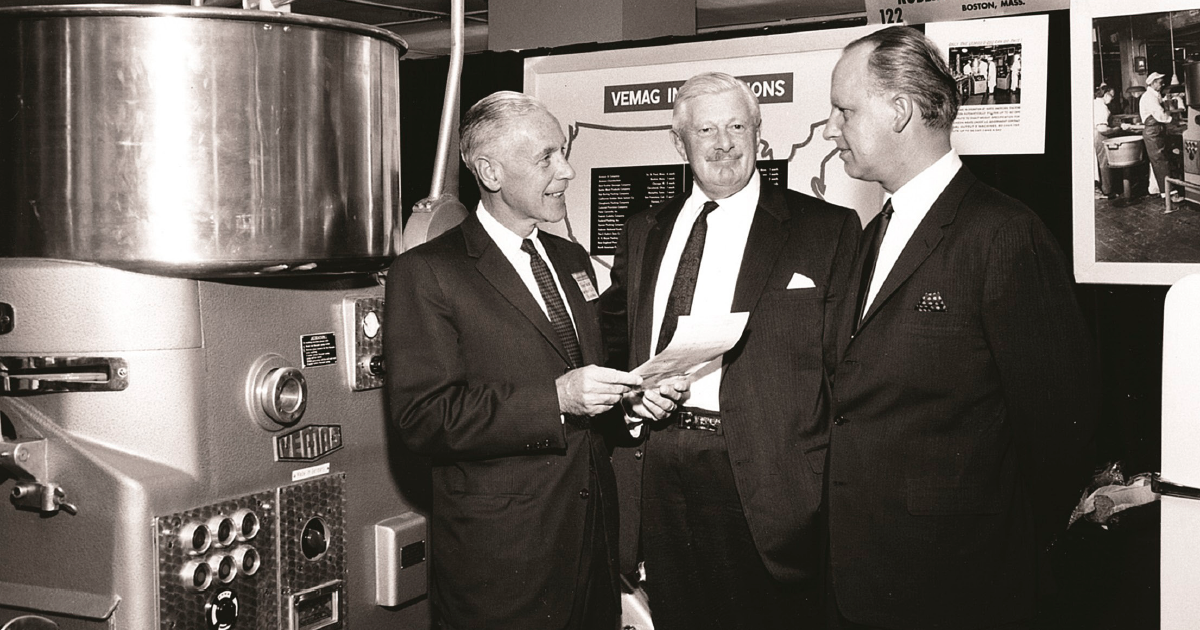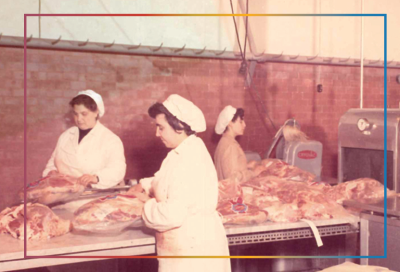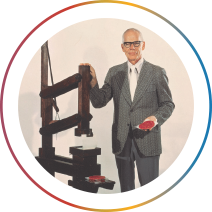By Kimberlie Clyma
November 2021
Technological
Evolution
Today’s productive, efficient and safe meat processing industry owes its advancements to the pioneers of the past


Reiser
At the turn of the 20th century, meat packing was the largest industry in the United States – it was responsible for $1 billion in annual sales. Today, annual sales total more than $150 billion in meat packing and processing and $65 billion in poultry slaughter and processing.
In the early 1900s, giant slaughterhouses and meat packing plants were found in the Midwestern Heartland in cities such as Chicago, Milwaukee and Kansas City, which were nestled between the many ranches in the Western part of the country and the growing cities sprinkled on the East Coast. Today, meat processing plants are located east to west, north to south, in an industry that employs more than 500,000 people – and more than 2 million people along the supply chain including those who supply the packing and processing industries with ingredients and equipment and the many who work in transportation, retail and foodservice.
The meat processing industry is not only responsible for the growth of meat production and consumption across the country, but it helped to shape several technological advancements used in meat processing and packaging itself and in other production-related industries. It was responsible for the rise of the railroad industry, the labor movement and transportation, not to mention innovations such as industrial refrigeration, the assembly line and vacuum packaging. Tales of the pioneers of these technologies can be found in the storied histories of the industry’s equipment leaders, many of whom are still involved in the meat industry today.
First machines, then processes
Meat packing plants began appearing in the United States in the early 1800s, mostly on the East Coast. But by the mid-1800s growth moved to the Midwest as the Chicago Stockyards became the biggest US livestock market and meat packing plants emerged in other Midwestern cities. As more consumers started demanding meat, meat packers looked to expand and mechanize their operations. Little by little, meat processing equipment started becoming available, making the business of breaking down carcasses and processing the meat more profitable.
The early meat processing equipment pioneers made it possible for meat packers to streamline their operations, increasing production amounts and production speed.
“Many of the early equipment manufacturers worked with the intention of improving not just processes, not just trying to make more money, but they were trying to make things better for people,” said Brent Meyer, owner of Brent Meyer Communication. “They were asking themselves: ‘How do we get food to other places? How can we transport food better? How can we make things safer?’ A huge part of the industry that many people don’t think about, is the idea that they were working to make a system, a process or a product better.”
Historians credit the last couple of decades of the 1800s and first few decades of the 1900s with a number of the primary inventions used in today’s meat processing environments. In the 1880s, mechanical mixers, stuffers and choppers were developed. By the early 1900s, cure pumps, slicing machines and conveyorized tables were invented. And by the 1920s, band saws and meat grinders made meat processing faster and easier.
The father of the modern meat grinder was said to be Karl Friedrich Christian Ludwig Freiherr Drais von Sauerbron from Germany. He invented the manual meat grinder in the mid-1800s. He also invented the typewriter, a stenograph machine and a “wooden running machine” that later evolved into the modern bicycle.
Two women are credited with helping to shape the way meat is cut in processing environments today. First, in 1813, an American Shaker in Massachusetts named Sarah “Tabitha” Babbit invented the circular saw. Bandsaws were later invented and in 1846, Anne Pauline Crepin from France invented a way to weld the ends of the bands securely together, allowing band saws to successfully function.
“Thousands of technological developments, innovations in engineering designs and incremental improvements in food manufacturing equipment and technology have been put into place since the early 1900s,” said David Seckman, president and chief executive officer of the Food Processing Suppliers Association, which represents the suppliers to the food processing and packaging industry. “Today’s food processing and packaging is radically different than that of 100 years ago.”
Cozzini Bros. started out as a one-man knife sharpening business on the streets of Chicago and evolved into a 4th generation family blade business (now called PRIMEdge). After years of simply sharpening blades for butcher shops and restaurants, Cozzini Bros. took the next step into the processing world, sharpening bowl choppers, grinding plates and slicing blades. Their quest for more efficiency and consistency, led them to create shelf-sharpening blades for continuous production bowl choppers using pumps and pressure. One thing led to another, and the company started producing blending, conveying and pumping systems before selling to Middleby in 2010. Now they’ve gone full circle and their current company, PRIMEdge, is back in the blade business.
“Suppliers like us had a lot of opportunities to evolve through the years,” said Ivo Cozzini, CEO of PRIMEdge. “We had opportunities to really think things through, to become more automated, safer, and make better pieces of equipment. The more you could evolve, the more successful you could be.”

Moving down the line
Early signs of automation can be traced back to the late 1800s when meat packing facilities started to use an assembly line system to move product through the operation. In the 1870s, in plants in Chicago and Cincinnati, slaughterhouses used monorail trolleys to move the carcasses past the line of workers, each of whom performed a specific task. This is often historically referred to as a “dis-assembly” line.
The process of different workers performing singular tasks was later adopted by other industries, but not truly recognized for its efficiencies until Henry Ford designed an assembly line in 1913 to manufacture his Model T cars. He credited the meat packing “dis-assembly” lines with giving him the idea. Thanks to this highly efficient process (which cut the time it took to assemble a car from 12 ½ hours to 93 minutes), Ford was able to drastically reduce the price of its automobiles.
“Many initial advancements were focused on providing faster machines that could handle more capacity, but as the technology improved so did innovation,” said Wayne Bryant, senior vice president of sales for Reiser USA, which was founded in 1959 as the service and sales agent of Germany-based Vemag. “For example, electronic advancements led to more precise machines that provided better, more consistent portions and limited re-works and waste. Improvements in packaging resulted in more attractive solutions that provided better food safety and longer shelf life while using more sustainable materials. The one thing driving all this change and innovation has been processor need.
“The need for increased automation has driven technological advancement in the equipment industry for decades. Processors have always looked for solutions that can provide more capacity, faster throughput, and more efficiencies. Throughout history they have wanted solutions that enable them to be more precise, more productive, and more profitable, and that continues today,” Bryant said.
Wrap it up
As a part of this year’s Pack Expo show in Las Vegas, PMMI – The Association for Packaging and Processing Technologies, put together an exhibit called Pack to the Future, which featured 25 historic machines, more than 230 photos, 250 packaging facts and a lineup of speakers. Jack Aguero, president of Aguero Associates, and Meyer were co-curators for the event. During the 18-month long process of procuring equipment, photos and facts about the history of packaging, the two learned a lot about the evolution of the industry and its impact on society as a whole, as well as on its influence on the meat industry.
Packaging can trace its roots back for centuries. Pottery was an early form of packaging, as was paper, glass, metal and later plastics. Each material has its own history and evolution through the years and variations in uses, especially when it came to food.
“As civilizations developed, goods needed to be packaged for transport. Packaging grew in sync with the ideas of commerce and trade,” Meyer said. “Historically, you can see how packaging has really impacted and benefited mankind. Many of the things that we have today are because of how packaging has evolved. Culture wouldn’t have developed the way it has throughout history if we didn’t have packaging.”
Some packaging developments were out of necessity, while others occurred almost by accident. In 1809, General Napoleon Bonaparte offered 12,000 francs to anyone who could find a way to preserve food for his troops. Nicholas Appert, a Parisian chef, discovered how food sealed in glass containers and then boiled would help food stay fresh for long periods. But glass wasn’t ideal for transporting to the troops, so soon after Peter Durand of Britain received a patent for inventing the tin can.
“The Industrial Revolution is really where modern packaging began,” Aguero said. “1795 to 1850 was the very beginning of modern packaging. Then from 1850 to 1900, the first packaging machines started to enter the market. Between 1900 and 1950, packaging machinery became a powerful industry.”
Did what was going on in society effect the development of different types of packaging or did new packaging help to change the culture? Arguments can be made for both. “Packaging and society have a very symbiotic relationship,” Meyer said. “Changes in society have helped to drive packaging and then packaging also makes changes in society.”
Seckman explained further, “Back in the early 1900s, preparing food for the nightly family dinner was labor intensive and normally took hours to prepare. There were very few processed foods to provide ready-to-cook options. Then, times changed. In the early 1920s, processed foods were beginning to be introduced into stores. World War I brought a new innovation – canned foods – which were created for our troops. After the war, gas stoves, newer kitchen appliances and refrigeration allowed families to purchase, store and prepare food more easily. And, in the 1930s, more ready-to-eat foods hit the market.
“With each passing decade, the food industry has evolved and the manufacturers of food processing and packaging equipment have continued to work with processors on a consistent basis in order to meet, address and further improve upon the technology needs of the industry.”
The ‘Kleenex’ of packaging
“The world interacts with packaging, and the world, in some ways drives packaging,” Aguero said. “There’s always somebody in the packaging industry who is going to try to invent a better way to do something.”
Enter, Cryovac.
In 1941, the Cryovac brand was born, and later that brand would be synonymous with meat packaging. The trademark was filed by the Dewey and Almy Company, which later became the W.R. Grace Co. In 1998, the Cryovac brand and technology was purchased by Sealed Air. Many meat plants to this day call their packaging room, the “Cryovac room.”
“When you think about some products you automatically think about certain iconic brands, like Kleenex and Jell-O and Band-Aid. I would put our brand Cryovac right there with them,” said Shawn Harris, executive director of marketing for Sealed Air’s Food Protein Platform. “Cryovac has become synonymous with vacuum packaging, and there’s a great sense of pride with that.”
In 1946, Cryovac began testing monomer bags as the first Cryovac Barrier Bag utilizing a snorkel vacuum that was sealed with a metal clip. The first equipment produced was the 8200 model that vacuumed and clipped the co-extruded barrier material.
“The piece of meat would come down the conveyor, the employee would grab it, put it on the hose, suck the air out of it, clip it and put it back on the conveyor before the next one came down,” Harris said. “It was very labor intensive.”
In 1975, Cryovac introduced the 8300 series of Rotary Chamber Vacuum Machines. This machine enabled increased throughput with its rotary design (often referred to as the “octopus”) and eliminated the clip by using heat seal bars that were water cooled.
“This was the machine that enabled the beef industry to transform,” Harris said. “Now carcass beef could be cut and primals could be marketed across the country.”
You might also enjoy:
Overcoming obstacles and chasing innovation, the pet food industry prepares for its promising future.
Today’s meat and poultry processors carefully manage expectations to feed people, preserve the planet and deliver profits in the future.
Association connection
Thinking out of the box
After decades of selling beef in carcass form (fore and hind quarters), packers began to further process wholesale cuts of beef and vacuum package them in smaller, sub-primal portions. It allowed for shipping cost savings and took advantage of the increasing demands by supermarkets for specific cuts of meat. This “boxed beef” idea was developed by a beef packer founded in 1960 in Denison, Iowa, called Iowa Beef Processors (later known as IBP, and purchased by Tyson Foods in 2001).
“We would still be marketing beef swinging on hooks without this technology. But now a retailer didn’t have to buy a whole side of beef and hope they could sell it all. They could buy what they needed for their market and just sell that,” Harris said. “Boxed beef really was one single thing that changed the value of the whole chain. It took so much waste out of the system.”
The pork industry continued to wrap its products in paper until the 1980s.
While IBP is credited with developing the idea for boxed beef, Cryovac’s rotary chamber vacuum packaging machine gave the packers the tools and technology to make it happen.
In a 2001 interview with Livestock Weekly, Robert Peterson, former IBP chairman of the board and CEO, said, “The company that really made boxed beef possible was Cryovac.”
“It’s powerful when someone that’s one of your largest customers and a pioneer in the industry says, ‘This would not get done without Cryovac,’” Harris said. “These are the things that change industries.”
Vacuum packaging is still readily used today, as equipment suppliers continue to advance the technology. Modified atmosphere packaging (MAP) technology, developed in 1979, differs from vacuum packaging in that it doesn’t necessarily remove oxygen from the packaging, it just adjusts the oxygen and CO2 levels in the package. Both provide added shelf life and allow processors to expand product offerings and distribution, efficiently and safely.
“From vacuum packaging to modified atmosphere packing and now high-pressure processing, the evolution of packaging continues,” said Jorge Izquierdo, vice president of Market Development for PMMI. “The demand for convenience keeps growing, so new technologies will continue to be developed to meet those demands.”

Sometimes it’s the little things that make a big impact on history. When it comes to the origin of the hamburger, there are some disputes as to where and when the popular Hamburger Steak was first put between two pieces of bread and turned into the popular hand-held dish so many people enjoy today – most historians say it was between 1885 and 1904.
Some say it happened at the Erie County Fair in 1885, others say a Texas cook named Fletcher Davis was the first to serve hamburger steak between two pieces of Texas toast. And, then there’s Billy Ingram, founder of White Castle who launched his business in 1921 selling small, square hamburger “sliders” by the sack full.
When it comes to the mass production of hamburger patties, another name is found in the history books – Harry H. Holly.
Holly had been working as a structural iron worker when the Depression hit in the late 20s. After losing his job and struggling to find another, he and his wife opened a hamburger shop under the back stairs of his grandmother’s home in Calumet City, Ill. Despite the challenging times, his business grew.
However, he soon realized that molding the burgers by hand took too much time and didn’t allow for any consistency in the size and shape of the patties he was making. In 1937, Holly built a wooden squeeze press using the rim of a dinner plate as a form and molded the patties by pulling a lever. After tweaking his prototype a few times, he patented the machine.
He then sold his hamburger business and started building steel versions of his patty forming machine and Hollymatic Corp. was born. The company celebrated its 80th anniversary in 2017.
Today, Hollymatic and its sister companies Rollstock, NuTEC Manufacturing, Former and Patty Paper, create machines for every part of the meat processing line.
“All of those processes of processing the product are what we’ve built on from that initial springboard of a patty machine from Harry Holly – up and down the processing line,” said Sam Pantano, vice president of national accounts for Hollymatic. “We take it from cut it, grind it, form to process it and package it – we do it all.”
